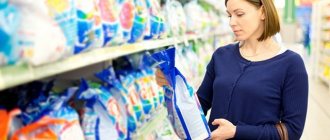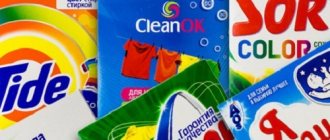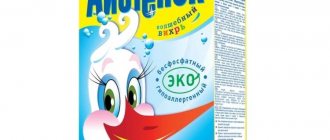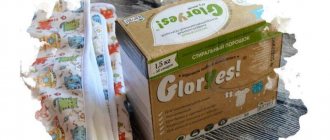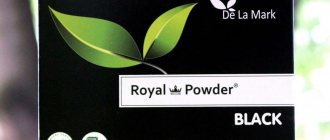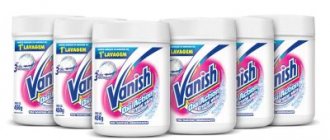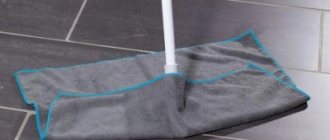Today, washing powder is taken for granted. Without it, a full process of washing things is impossible. However, just 150 years ago people had no idea what it was.
The article will discuss the history of the creation of washing powder, its benefits and harm to human health and the environment, and will list the leading manufacturers of laundry detergents and more.
Description of clothes washing detergent
Washing powder is a synthetic detergent related to household chemicals .
Powders have a complex, multicomponent composition, depending on which the specifics of their application differ.
All modern powdered products undergo granulation, which reduces the degree of dusting and also makes the process of use more convenient.
They are white in color, but in their composition you can often find multi-colored granules (green, red, blue, dark blue). The main purpose of powders is to remove dirt .
History of creation
The first washing powder was created by German chemist Fritz Henkel. Its basis at that time was sodium silicate. In 1876, Fritz organized the Henkel company, which began releasing a new product called “bleaching soda” to the masses. It quickly became popular because it washed things well and was inexpensive.
The first soap powder appeared on the market a year later. Its creators founded the company Thompsons Seifenpulver GmbH. At the same time, the Henkel factory developed.
In June 1907, the first washing powder for cars (Persil) saw the light of day. This saved housewives from having to boil things to make them white.
In Russia, washing powder appeared only in 1953 , it was a product called “Novost”. It was produced in Kazan at a chemical plant. A new round of development occurred in 2000, as a result, a powder with a composition familiar to modern people entered the market.
What's the harm?
The only benefit of powders is their ability to effectively remove various contaminants from things, making them clean. However, they are harmful to the human body and the environment.
For the human body
Surfactants that form the basis of washing powders are highly active compounds. When they enter the body, they accumulate in the cell membranes, covering them with a film and disrupting their functioning. If a lot of surfactants accumulate in the body, they disrupt metabolic processes and can even lead to cell destruction.
Anionic surfactants are especially dangerous . Their harmful effects on the body:
- impaired immunity;
- allergy provocation;
- brain damage;
- increased cholesterol levels in the blood, increased atherosclerosis;
- disruptions in the functioning of the nervous system;
- disturbances in the functioning of the liver, kidneys, and respiratory system.
Anti-active substances have the property of accumulating in internal organs. When they come into contact with unprotected skin, 0.6% of them settle in the liver, and 1.9% in the brain. They have a toxic effect on them.
Phosphates from washing powder only enhance the effect of anionic surfactants, promote their penetration through the skin and increased destruction of membranes. High toxic concentrations of surfactants remain on things for about 4 days.
Environmental impact
Drain water contains synthetic detergents. After processing, they end up in the sewer system and then in natural bodies of water. For the microorganisms living in them, the substances contained in the powders are poisons. They violate the organoleptic properties and biological parameters of water.
Moreover, wastewater containing dissolved powder has a pH level of 7-10, while for normal life of aquatic organisms it is 4.5-5.0. As a result, fish, reptiles and mammals suffer as the food chain is disrupted.
Due to surfactants and other harmful chemicals entering the water, water bodies begin to bloom, turning into swamps.
Variety of shapes and types
The following types of washing powders are distinguished:
Universal compositions for different types of washing.- Machine washing machines.
- For hand wash.
- For delicate washing.
- Contains disinfectants.
- For white and colored laundry.
- For children's clothing.
- With air conditioning.
- For washing in hard or cold water, etc.
Different manufacturers produce different powders. They differ not only in composition, but also in smell. There are three forms of laundry detergents:
- ordinary bulk powders;
- gels represented by liquid concentrates;
- capsules - they contain a highly concentrated liquid gel.
It is most convenient to use capsules, since they do not need to be dosed, they do not generate dust and do not irritate the respiratory tract. However, they cost 2-3 times more than classic washing powder.
Color catch napkins
Color-reflective wash cloths can be useful if you have a lot of clothes in different colors in your closet. For example, a white dress with dark blue polka dots or a white blouse with red stripes is definitely necessary so that the items do not become stained when washed.
The solution to this problem is color-catching wipes. Easy to use: just put it in the washing machine with a load of laundry.
One of the tasks of napkins is to protect against staining. During washing, this product picks up colored particles from clothing that can stain.
In addition, napkins ensure that clothes always retain their rich color.
The undoubted advantages include saving time and money. By not having to wash different colored fabrics separately, you can wash less frequently, which means less water and energy consumption.
In addition to color-catching wipes, they sell wipes for:
- Stain removers that trap dirt and make it easier to remove;
- Whitening;
- Aromatic.
Features of choosing a washing composition
When choosing a washing powder, you need to consider its purpose. A prerequisite is to study the composition. You should not buy household chemicals that have expired.
Other points to pay attention to:
- Amount of surfactants. According to existing standards, their percentage should be less than 5%.
- All foreign-made media must have Russian-language information.
- The composition should not contain phosphates; responsible manufacturers replace them with safer zeolites.
- Purpose of the detergent. If the label says “for white clothes,” then it is not recommended to wash colored items with them.
- The composition of baby powder should be as natural as possible.
- The packaging must be tightly sealed, without any signs of tampering.
Read about how to choose washing powder here, for children's clothes - here. The rating of hypoallergenic laundry detergents is presented in this article, odorless powders in this article, and eco-powders in this one.
The difference between powder for hand washing and automatic washing is discussed here, the features of choosing soap powder are here, safe for a septic tank - in this article, the rating of detergents according to customer reviews is presented here.
How much powder should I pour?
The amount of detergent depends on several factors:
- Volume of loaded laundry.
- The degree of contamination of clothing - the higher it is, the more bulk substance is required.
- Hardness of water. If there is a residue on the walls of the dish after boiling, the water is hard.
- This can be compensated for with softeners.
- Selected type of washing (hand or machine).
- Selected mode.
Some newer models have a function that automatically determines the amount of powder needed for washing.
Typically, the manufacturer indicates the proportions of the detergent on the packaging, but in practice you can adhere to the following recommendations:
- 1 tbsp. l. (20-25 g) per 1 kg of laundry, if it is slightly soiled;
- 1.5-2 tbsp. l. in the presence of stubborn stains and increased water hardness.
Top producing countries
Powder production is carried out in many countries, but the leaders in this industry are the following countries:
Japan. Japanese washing powders do not contain phosphates, as they have been banned in the country for several years. They are sold in convenient modern packaging and equipped with a measuring spoon. The most popular brands: Attack, Lion, Miyoshi, Daiichi FUNS, Mitsuei Super Wash.- China. Chemicals produced in China are economical in consumption, have a minimal amount of flavorings, are highly effective and have a hypoallergenic composition. Popular brands: Liby, Keon, BioAqua, Laundry Detergent Sheets, Touching Nature.
- Korea. The formula of Korean washing powders does not contain phosphates, and the main active component is enzymes (enzymes) that are safe for human health and the environment. The most popular TMs: KeraSys Spark Drum, OATS, Lion Beat, Hanjang.
- Russia. Most formulations do not contain phosphates and are also affordable. The most popular brands: Ushasty Nyan, Umka, Sarma, Vorsinka, Stork, Sorti, Lotus.
- Belarus. Washing powders from Belarus wash well, do not contain phosphates and undergo strict control when entering the Russian market. Popular brands: Mara, April, Chaika, SanDay.
You can learn about German washing powders from this article.
Rating of quality washing powders from the best manufacturers - 2022
Depending on what selection criterion is used by the consumer - how much the powder costs, its functionality, safety, popularity of the brand - he will be able to choose the product that suits him on the store shelves.
Inexpensive washing powders
Budget funds are always in demand among buyers, especially among those who do not have high demands on their composition: it is often not ideal for such powders.
Sarma Active
Suitable for white and colored items made from natural and synthetic fabrics (except silk and wool). Can be used for all types of washing. Kills dust mites. A complex of 5 enzymes effectively fights various types of pollution.
Sarma Active
Advantages:
- No chlorine in the composition;
- Antibacterial action;
- Copes with difficult stains;
- Affordable.
Flaws:
- The presence of aggressive components: a-surfactants (5-15%), phosphates, silicates, optical brighteners;
- When washing quickly, it does not rinse well.
Average price: 50 rub. for 400 g.
Tide White Clouds
Suitable for washing white items. Will cope with complex stains (from cosmetics, coffee, red wine, chocolate, herbs, etc.). The packaging states that it can be used for washing children's clothes, but experts do not recommend doing this: the composition contains a significant amount of a-surfactants.
Tide White Clouds
Advantages:
- Removes stains of various origins;
- Economical;
- Inexpensive.
Flaws:
- A pungent odor that remains on washed clothes;
- White items may appear blue;
- Unsafe composition.
Average price: 22 rub. for 150 g.
Losk 9 Total system
Its distinguishing feature is its versatility. The powder can be used to wash items made from linen and cotton, synthetic and mixed fabrics. Cannot be used on wool and silk items. Suitable for hard water. 9 components in the product get rid of stains.
Losk 9 Total system
Advantages:
- Removes dirt;
- Pleasant aroma;
- Budget.
Flaws:
- Unsafe composition: phosphonates, a-surfactants
Average price: 76 rub. for 450 g.
Popular brands of washing powders
Many of them came to our market back in the 90s and still remain a common choice of buyers. Often, when deciding which company's product is best to buy, consumers rely on television advertising.
Ariel Mountain spring automatic
According to housewives, it removes stains better than many other products. Perfect for washing bed linen, home textiles and cotton clothes. Not intended for caring for knitted clothing: after use it may shrink. Instead of phosphates, the composition contains zeolites (their disadvantage is that they make the laundry hard), a-surfactants are also present in significant quantities (5-15%) and optical brightener.
Ariel Mountain spring automatic
Advantages:
- Preservation of fabric whiteness during long-term use;
- Removing contaminants;
- Economical.
Flaws:
- Lots of A-surfactants, phosphates, zeolites, optical brightener in the composition;
- Not universal: not suitable for colored and dark linen, items made of delicate fabrics, knitwear;
- Cost is above average;
- May cause an allergic reaction.
Average price: 100 rub. for 450 g.
Persil Expert “Frosty Arctic”
It can be used when washing clothes made of any fabrics of different colors: black, white, colored. Among its components is a liquid stain remover in capsules, thanks to which even old stains disappear.
Persil Expert “Frosty Arctic”
Advantages:
- Does not contain phosphates;
- Universal;
- Removes stains well;
- Economical.
Flaws:
- High content of A-surfactants;
- Optical brighteners included;
- The aroma of the fragrance is felt for a long time on washed clothes.
Average price: 90 rub. for 400 g.
BiMax 100 spots automatic
A universal washing powder that is suitable for many types of fabric, with the exception of delicates. It removes stubborn stains well, including those from drinks and food. Used economically. Does not dissolve well in cold water.
BiMax 100 spots automatic
Advantages:
- Versatility;
- Fights pollution;
- Cost-effective;
- Relatively inexpensive.
Flaws:
- A-surfactants and phosphates in the composition;
- Inconvenient for washing in low temperature water.
Average price: 84 rub. for 400 gr.
Testing of individual tools - in the video:
This is a concentrated product, so its consumption will not be so large. Its composition cannot be called ideal (zeolites and surfactants are still present), but there are no phosphates, silicates, chlorine, or optical brighteners. Preserves the color of fabrics. Hypoallergenic. The manufacturer claims it as a detergent for washing clothes for adults and children.
Frosh Color Aloe vera
Advantages:
- Economical;
- Absence of some harmful components;
- Suitable for any type of washing;
- No chemical smell.
- Can be used for all types of fabrics.
Flaws:
- Expensive;
- Contains surfactants and zeolites.
Average price: 550 rub. for 1.35 kg.
Ecover Zero
Concentrated powder without aggressive surfactants and phosphates. Universal: can be used for both automatic washing and hand washing, suitable for all types of fabrics.
Ecover Zero
Advantages:
- No phosphates;
- Versatility.
Flaws:
- Contains zeolites;
- Not cheap.
Average price: 700 rub. for 750 g.
Mako Clean Universal
The A-surfactants included in the powder are plant-based. Designed for hand and machine wash. It can be used on all types of fabrics, except those that require special care. Suitable for removing dirt from children's clothing.
Mako Clean Universal
Advantages:
- Hypoallergenic;
- No chemical smell;
- Biodegradable packaging;
- Economically used;
- Safe composition.
Flaws:
- High price;
- Without pre-soaking, it may not be able to cope with complex stains;
- Available in online stores.
Average price: 1232 rub. for 2.95 kg.
Garden Universal
It contains not only phosphates, but also zeolites, aggressive surfactants, silicates and other components harmful to humans and nature. The manufacturer positions the product as 100% natural (consists of soap and soda). It can be used to wash both adults and children's clothes: it will not cause an allergic reaction in people with sensitive skin. Concentrated, it is used sparingly, which is important because it cannot be classified as budget funds. Can be used for all types of washing.
Garden Universal
Advantages:
- Naturalness;
- Versatility;
- Hypoallergenic;
- Economical.
Flaws:
- Doesn't cope well with old stains.
Average price: 400 rub. for 1350
Hand washing products
The following requirements are traditionally imposed on them: efficiency, ability to rinse well and gentle treatment of the skin of the hands.
Sarma hand wash
The powder is suitable for washing light-colored items. It dissolves in water without problems, does a good job of removing stains, and is easy to wash out.
Sarma hand wash
Advantages:
- Does not contain chlorine;
- Whitens and disinfects fabric;
- Destroys linen mites;
- Relatively inexpensive.
Flaws:
- Phosphates, a-surfactants, silicates, fragrance, optical brightener in the composition.
Average price: 60 rub. for 400 g.
Ariel Hand Wash Clean De Luxe
Designed to remove various types of contaminants at any water temperature. Dissolves well and rinses out.
Ariel Hand Wash Clean De Luxe
Advantages:
- Cleans well;
- Pleasant aroma.
Flaws:
- May dry out the skin of the hands;
- Imperfect composition: contains a significant amount of a-surfactants, phosphonates;
- Not cheap.
Average price: 130 rub. for 450 g.
Pemos Authority
Can be used for items made from different fabrics, except delicate ones, at any water temperature. Copes with stains of varying complexity, including coffee, tea, berries and vegetables.
Pemos Authority
Advantages:
- Inexpensive;
- The smell is not strong;
- Removes dirt well.
Flaws:
- May have adverse effects on the skin of the hands;
- Unsafe composition: a-surfactant in significant quantities, optical brightener.
Average price: 45 rub. for 50 g.
Detergents for washing children's clothes
When purchasing children's washing powder, you must pay attention to its composition: it should not contain phosphates and phosphonates, a-surfactants in significant quantities, fragrances, or bleaches. The basis of this product is baby soap and components of plant origin.
Eared nanny
The product of this brand is very popular in our country. Many buyers are satisfied with its quality and effectiveness: it effectively destroys specific “baby” stains: from juices and purees, paints and felt-tip pens, and waste products. On the other hand, some parents have complaints about the composition: it contains anionic surfactants, phosphates, silicates, optical brightener, and fragrance.
Eared nanny
Advantages:
- Removes dirt;
- Does not require pre-washing or boiling;
- Suitable for different types of laundry.
Flaws:
- Unsafe components;
- May cause allergies.
Average price: 285 rub. for 2.4 kg.
our mother
Made from soap shavings. Can be used to care for newborns' clothes. Hypoallergenic. Suitable for all types of washing.
our mom powder
Advantages:
- Safety;
- Versatility.
Flaws:
- Does not always cope with stains without first washing;
- Less informative instructions;
- Dissolution of the product takes time.
Average price: 950 rub. for 2.2 kg.
Compound
The basis of all washing powders are anionic and nonionic surfactants. These surfactants weaken the bonds between contaminants and fabric fibers and prevent them from re-settling.
In addition to surfactants, the composition of laundry detergents is represented by the following components:
- Optical brighteners that create the illusion of snow-white laundry. This effect is achieved due to the deposition of luminescent particles on the fabric. When sunlight hits them, things appear white.
- Oxygen bleach.
- Soda and soap. They are designed to improve the quality of washing.
- Fragrances and flavors responsible for eliminating unpleasant odors and adding freshness to washed laundry.
- Phosphates. These components are necessary to soften water, which improves the quality of washing. Phosphates make laundry soft and protect washing machine elements from scale.
- Zeolites. They act as a safer alternative to phosphates.
- Sodium silicate, which alkalizes surfactants and also binds powder dust into granules.
- Enzymes (enzymes). They break down different types of contaminants through the manifestation of their biological activity.
- Defoamers. These substances prevent excessive foam formation.
Other components:
ballast substances,- solvents,
- chlorine,
- hydrotropes,
- anti-corrosion compounds,
- preservatives,
- antioxidants,
- additives that soften the skin of the hands,
- air conditioner, etc.
Read more about the composition of washing powder here, and about the GOST requirements here.
Features of use
Recommendations for using washing powders:
- compliance with dosage and temperature conditions;
- use of powders according to their intended purpose (for white and colored laundry, for children, for people with hypersensitive skin);
- when washing in an automatic machine, the powder is poured into the first compartment only if the pre-wash or soaking program has been selected; in other cases, the detergent is poured into the second section;
- taking into account the concentration of chemicals - if the powder is concentrated, the dosage is reduced.
Woolen, half-woolen and cotton fabrics absorb surfactants the most, so they need to be rinsed especially carefully.
The rating of washing powders for colored items is presented in this article, for black - in this article, for white - here, for hand washing - here.
Is it possible to pour powder directly into the drum? This article will tell you where to put it correctly, in which compartment - this one, how much to pour - this one.
Rinse liquids
Fabric softeners are a product whose main task is to give fabrics softness and a fresh aroma. In addition, the following means:
- Reduces drying time for clothes;
- Additionally, they smooth out wrinkles on clothes, thereby speeding up and facilitating the ironing process;
- Prevents static electricity on clothing;
- Does not attract dirt particles.
Some products contain fragrances that can cause allergies, such as rashes.
When using air conditioners, you must follow the manufacturer's instructions. Thanks to the recommended amount per wash, it will be much easier to rinse the detergent from the fabric.
It is also worth remembering that conditioner should not be applied directly to the fabric, as this can damage the fibers.
Storage conditions
The composition can be stored both in the original packaging and in other suitable containers. The main thing is that the container is tightly closed . Do not allow moisture or debris to get inside.
The room chosen is dry, dark and cool. Children should not have access to detergent. It is important to monitor the expiration date of the composition and not use expired products. Read about expiration dates for washing powders here.
Example No. 3
Rp.: Streptocidi 0.12 Analgini 0.1 Magnesii oxydi 0.15 Mf pulvis Dtd No. 6 S. 1 powder 3 times a day after meals
Analgin - list B, checking doses. (on the reverse side of the PPK)
Reverse side of the PPK:
M(streptocide) = 0.12*6 = 0.72 g Amount of alcohol 95% 5 drops per 1 g X drops per 0.72 g X = 4 drops M(analgin) = 0.1*6 = 0.6 g M (magnesium oxide) = 0.15*6 = 0.9 g Mo = 0.72+0.6+0.9 = 2.22 p1 = 2.22/6 = 0.37 g
Front side of the PPK:
Streptocidi 0.72 Spirithi aethylici gtts IV Analgini 0.6 Magnesii oxydi 0.9 ____________________
Mo = 2.22 g p1 = 0.37 g
Prepared: Checked: Packaged:
Technology:
Streptocide is a difficult substance to grind, so we grind it first with 4 drops of 95% ethyl alcohol. Add 0.6 g of analgin, grind and mix. Lastly, pour in 0.9 g of magnesium oxide, because easily dusty. Mix thoroughly. We check for uniformity by pressing with a pestle on the center of the powder mass - there are no reflections or inclusions.
Shelf life: 10 days.
Label: "Internal", "Powders"
We pack in waxed capsules, fold them in groups of 3, and place them in a paper bag.
Helpful information
Tips for choosing and using washing powder:
If you want to protect yourself as much as possible from exposure to harmful substances, you should give preference to soap-based powders.- You need to choose powders with a low pH level, which is close to the pH of the skin, which is 4.5.
However, you should be prepared for the fact that this level of acidity negatively affects the cleaning properties of the composition, so it will be worse to wash. - When washing by hand, you need to protect the skin of your hands from contact with the washing solution.
- Dust from laundry detergent can remain in the air for about 20 minutes. Therefore, it is strongly recommended not to place a washing machine in the kitchen.
How to replace washing powder if you run out of it, you can find out here, how to make it yourself - here.
Example No. 4
Rp.: Natrii hydrocarbonatis 0.2 Dimedroli 0.03 Phenylii salicylatis 0.08 Mf pulvis Dtd No. 6 S. 1 powder 3 times a day after meals
Diphenhydramine - List B, dose check required. (on the reverse side of the PPK)
VRD = 0.03 LSD = 0.03 VSD = 0.09 LSD = 0.09 Doses are not excessive
Reverse side of the PPK:
M(sodium) = 0.2*6 = 1.2 g M(diphenhydramine) = 0.03*6 = 0.18 g M(phenyl salicylate) = 0.08*6 = 0.48 g Amount of alcohol: 10 drops per 1 g X drops per 0.48 g X = 5 drops
Mo = 0.48+0.18+1.2 = 1.86 g p1 = 1.86/6 = 0.31 g
Front side of the PPK:
Natrii hydrocarbonatis 1.2 Phenylii salicylatis 0.48 Spirithi aethylici gtts V Dimedroli 0.18 __________________________________________ Mo = 1.86 g p1 = 0.31 g Prepared: Checked: Packaged:
Technology:
We rub the pores of the mortar with 1.2 g of sodium bicarbonate, pour it all onto the capsule. Grind phenyl salicylate with 5 drops of ethyl alcohol, add 0.18 g of diphenhydramine, grind and mix. Add sodium bicarbonate from the capsule in several stages. Mix thoroughly. Check for homogeneity and pack into waxed capsules. Shelf life: 10 days. Label: "Internal", "Powders", "Keep out of reach of children"

